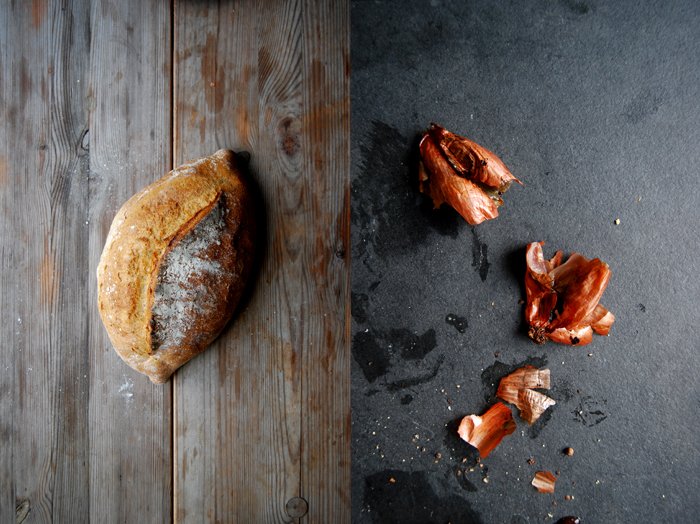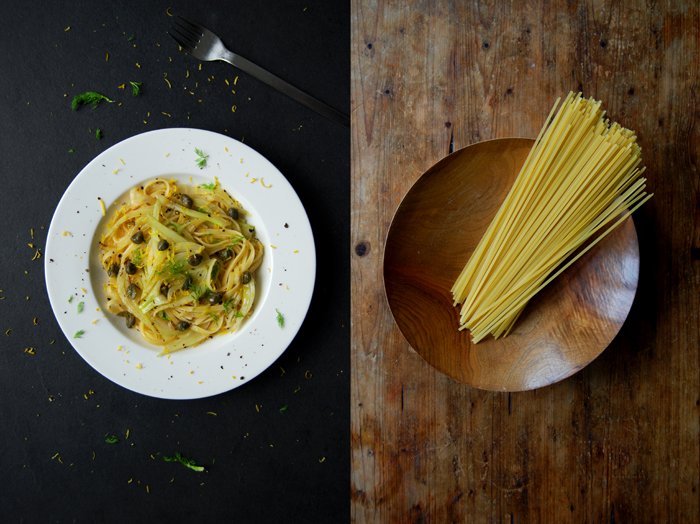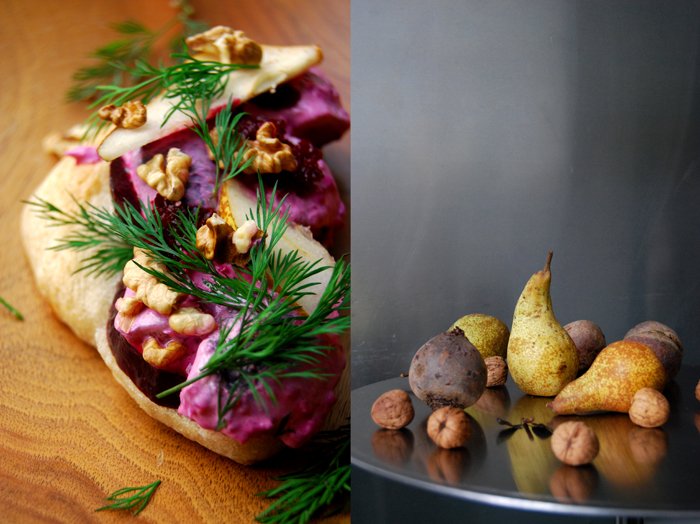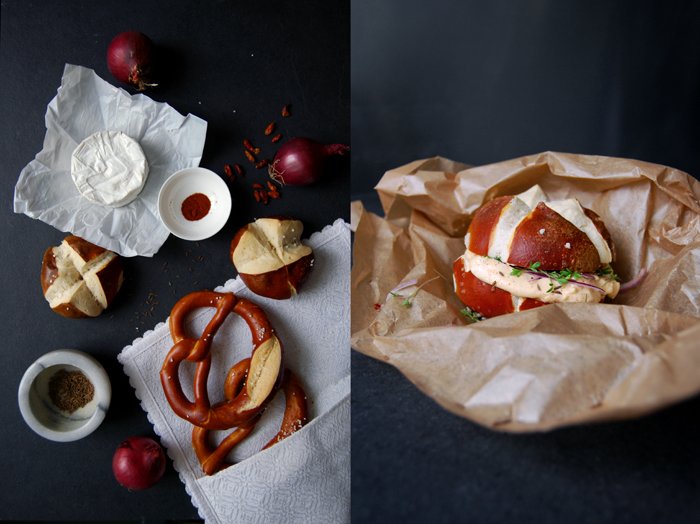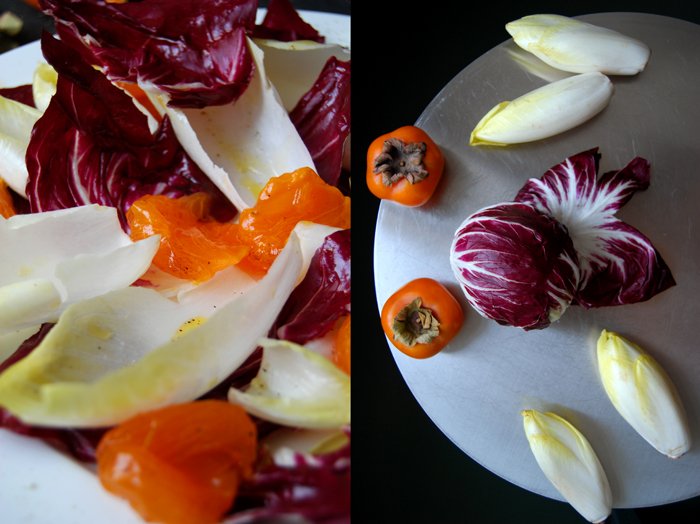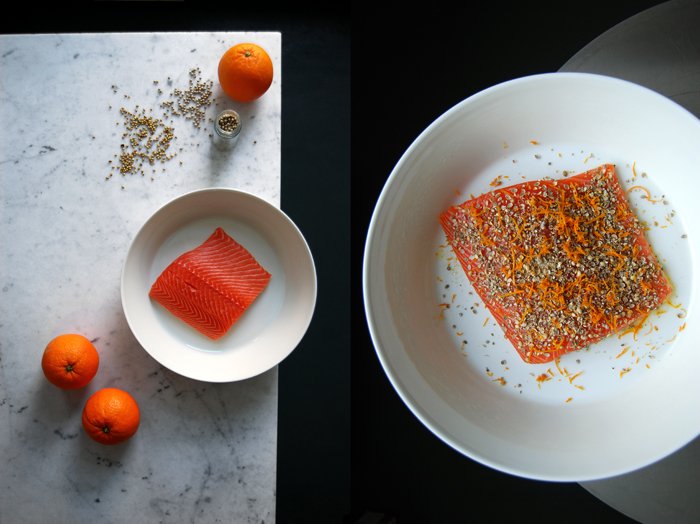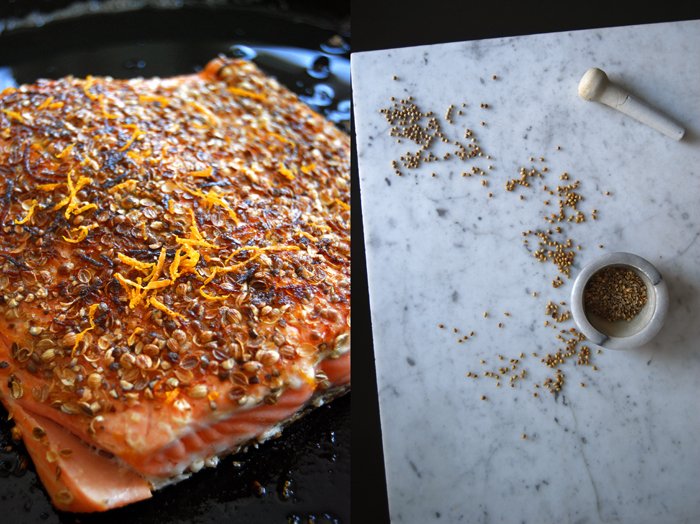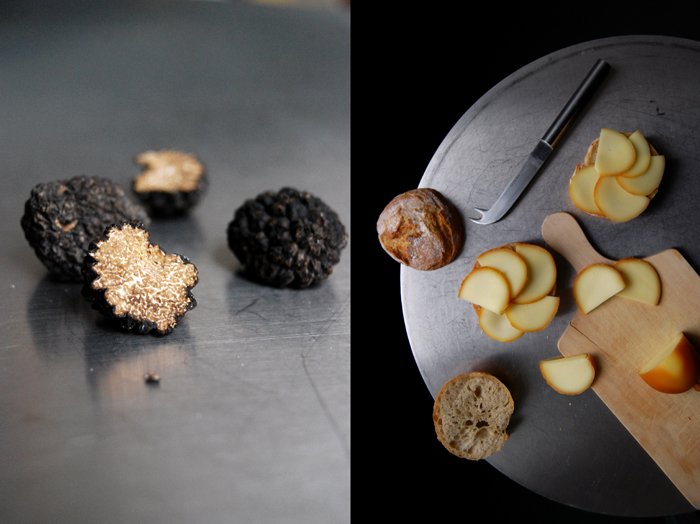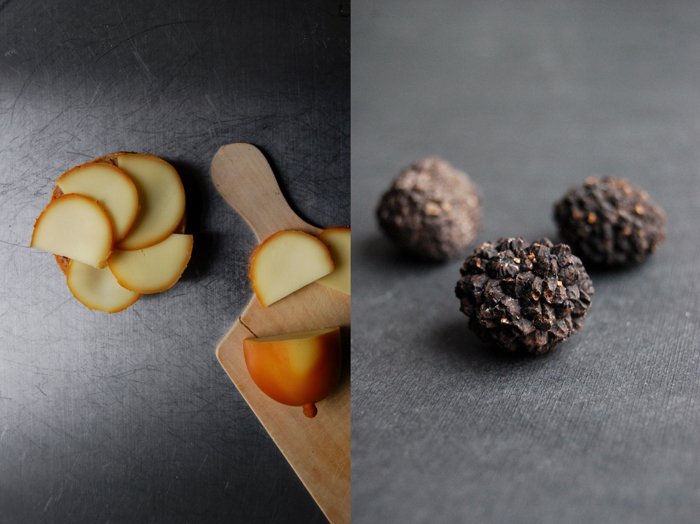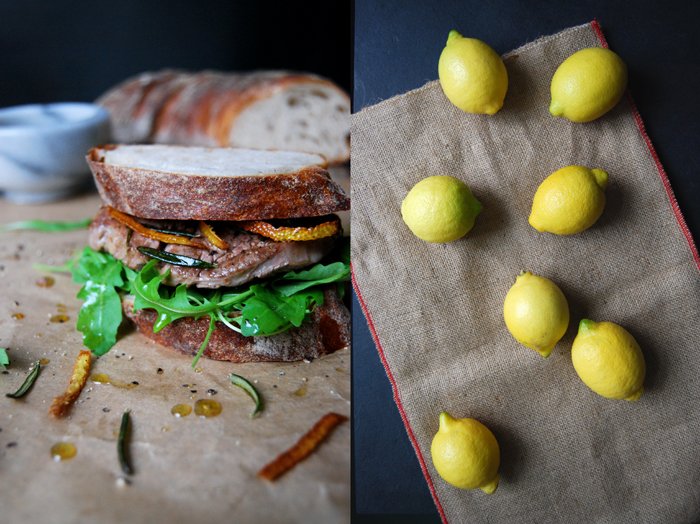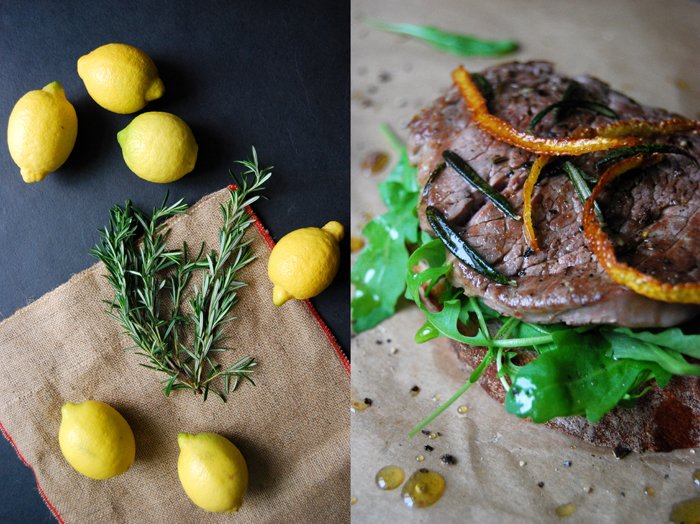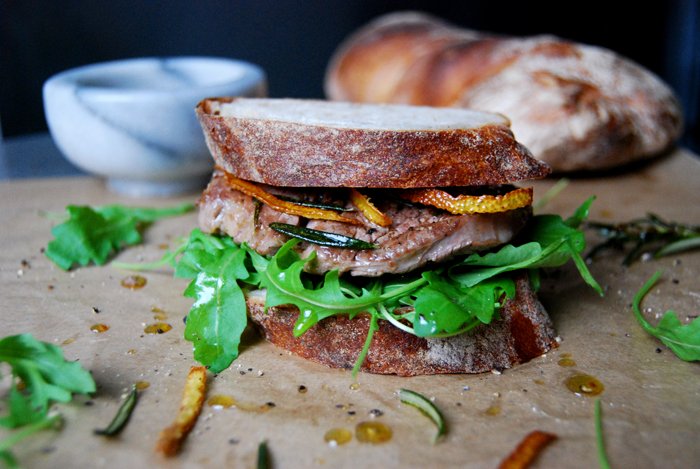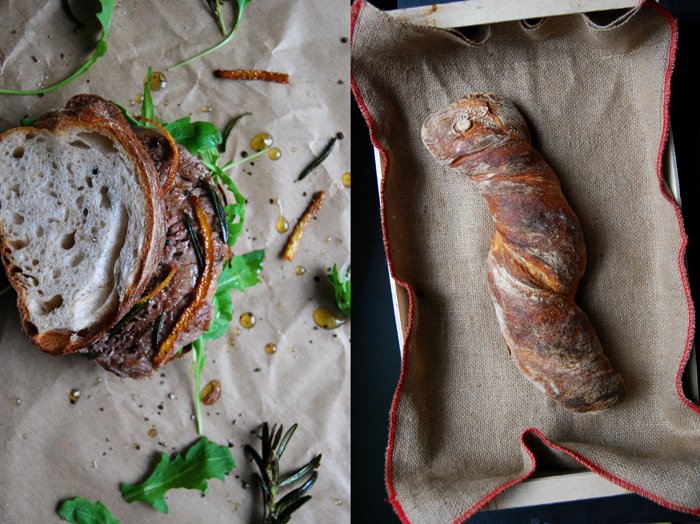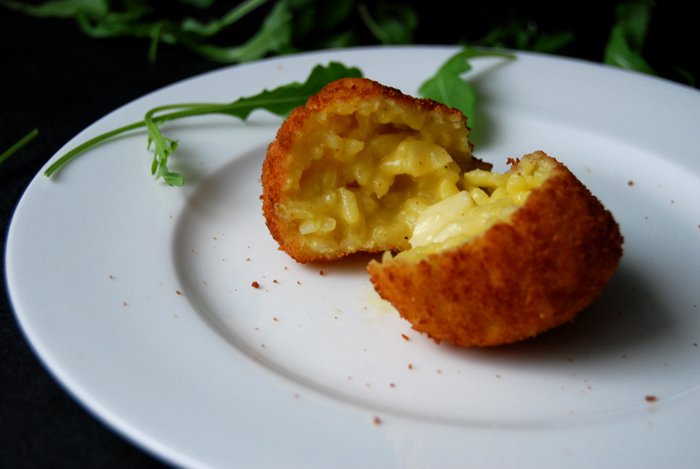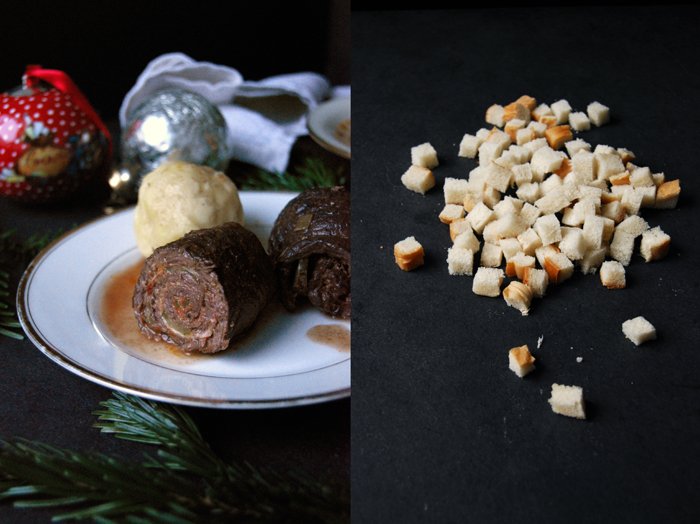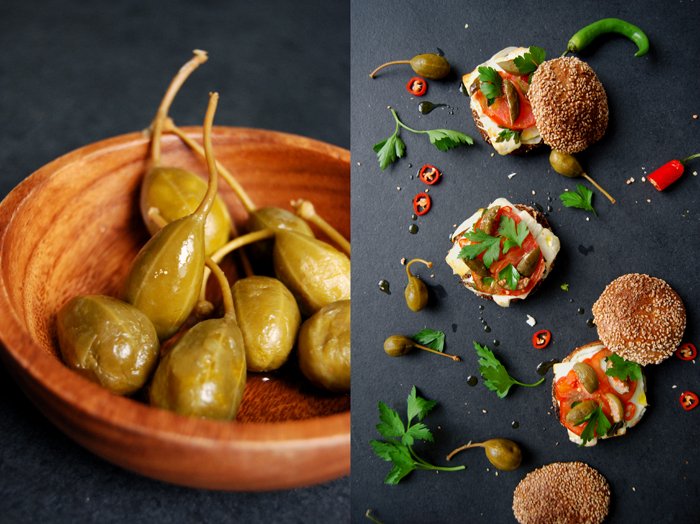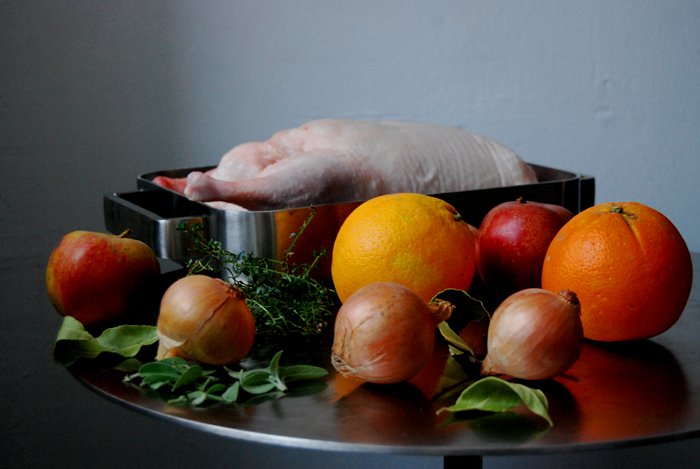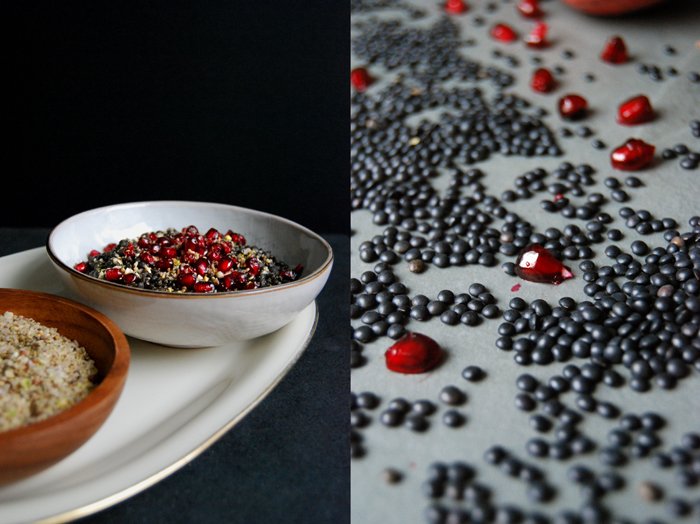Seared Tuna with Ginger, Lemon, Butter Beans and Onions
A tuna salad with white beans and onions is a wonderful light treat on a warm, summery evening, unfortunately, this is not exactly the kind of scene I find in wintery Europe at the moment. However, with a few minor changes, this dish can become something that can satisfy the needs of a cold day in January. Replace the canned fish with a fresh steak, add some warming ginger and crushed black peppercorns to it, and you'll see it in a different way. Instead of the small cannellini beans which are perfect for salads I went for a can of butter beans. The big, velvety legumes are rich and quite filling, a small plate is more than enough and you won't feel hungry for hours! This is why I prefer them in the cold season, for hearty dishes like my butter bean and fennel soup, although they are often featured in Mediterranean summer dishes.
The preparation didn't take any longer than the salad: I seared the firm steak for just a minute on each side as I wanted it to stay slightly pink inside, if you leave it on the heat too long it becomes dry. Some like to cook tuna for a few seconds to keep it completely raw but that's not my thing, other recipes recommend finishing it in the oven for a minute after it's been pan-seared. My piece was about 2 1/2cm / 1" thick and it was cooked to perfection. I sprinkled the tuna with freshly grated ginger and lemon zest and put it on top of the beans mixed with thin slices of red onions. The vegetables had a fruity dressing made with olive oil, freshly squeezed orange juice, white Balsamico vinegar and some of the grated root and citrus peel to pick up the aromas. It felt like a far away summer memory in a different setting which is great as long as it tastes so good!
I also don't want to miss out on telling you some great news: I'm so excited, eat in my kitchen has been featured in the German food magazine Lust auf Genuss! In the February print issue you can find an interview with me and an orange and lemon recipe I developed for the magazine with lamb chops and mashed potatoes.
Seared Tuna with Ginger, Lemon, Butter Beans and Onions
As a lunch for 2 you need
tuna steak (about 2 1/2cm / 1" thick) 200g / 7 ounces (take 2 steaks for 2 hungry people)
canned butter beans, rinsed and drained, 240g / 8 1/2 ounces
small red onion, cut in half and very thinly sliced, 1
olive oil 3 tablespoons plus more for frying
freshly squeezed orange juice 1 tablespoon
white balsamic vinegar 1 tablespoon
lemon zest about 1/4 teaspoon
fresh ginger, grated, about 3/4 teaspoon
salt and pepper
Whisk 3 tablespoons of olive oil, the orange juice, vinegar, half the lemon zest and 1/2 teaspoon of the grated ginger and season with salt and pepper to taste. Mix the beans and onions with the dressing and arrange on plates.
Heat a little olive oil in a pan and sear the tuna for 1 - 1 1/2 minutes on each side, the inside should stay pink. Season with salt and pepper and sprinkle with the remaining ginger and lemon zest. Serve on top of the beans.
A messy Sandwich with Roasted Shallots, Grilled Gruyère and Chutney
I'm in a mountain mood again, losing myself in thoughts of a warm wooden hut with an open fire place and wide snowy views. This calls for onions and cheese on my sandwich, or rather, tiny shallots roasted in their skin until they turn sweet, sticky and juicy, almost caramelised with aromatic gruyère, grilled until golden brown and bubbling. With these two pictures (and flavours) in my mind, I knew that I wouldn't need much else for today's messy sandwich.
I bought a crunchy sourdough bread, a rustic French loaf, strong enough to compete with the final addition to my hearty sandwich, homemade chutneys and marmalade. Our kitchen table was covered in jars with plum, rhubarb, red pepper and apple chutney, and in a moment of culinary cockiness, I decided to try it with some of my tangerine jam. I started by roasting the delicate onions for less than half an hour before I snipped the ends off and squeezed their juiciness onto the hot grilled cheese. One bite after the other, I tried all the different fruity spreads to come to the conclusion that the golden citrus fruits are interesting but quite a challenge for the taste buds and my plum chutney is the winner. Onions, gruyère and plums simply can't go wrong!
A Sandwich with Roasted Shallots, Grilled Gruyère and Chutney
For 3 sandwiches you need
rustic sourdough bread 3 or 6 slices (if you want a closed sandwich)
small shallots, in their skin, 9 - 12
gruyère, or another strong, hard mountain cheese, thinly sliced, 200g / 7 ounces
a fruity chutney, for the topping
black peppercorns, crushed in a mortar, for the topping
olive oil
Set the oven to 200°C / 390°F (I used the Rotitherm setting).
Coat the shallots in a little olive oil and roast in the hot oven for 25 minutes or until soft, turn them after 15 minutes. They should feel soft when you push them down gently.
Spread the gruyère on the slices of bread and put them under the grill for 1 - 2 minutes until the cheese starts bubbling. Snip the ends off the onions and squeeze them onto the cheese. Sprinkle with chutney and pepper and enjoy!
Linguine with Fennel, Capers and Lemon
My fennel carpaccio with salty capers and lemon is one of my favourite winter salads, I always have a couple bulbs in the fridge to prepare this 2-minute lunch or dinner for us. The vegetable is a tasty alternative to cabbages because, for whatever reason, it retains its strong aroma even when it's out of its (natural) season. It's always strong and present, be it baked in the oven as a gratin with Parmesan sprinkled on top, with butter beans in a hearty soup or as a crunchy addition to salads. I would definitely suffer much more from the absence of summery tomatoes, zucchini and bell pepper if there wasn't fennel in the house!
It's been a while since we had a plate of pasta on our table, which is quite unusual for us. Inspired by my carpaccio, I pulled the linguine package out of the pantry and mixed it with thin fennel slices sautéed for just 2 minutes, a handful of capers from Gozo, lemon zest and juice. It was a quick and light dish, tasty and simply good!
Linguine with Fennel, Capers and Lemon
For 2 people you need
linguine 200g / 7 ounces
medium fennel bulb, bottom cut off, very thinly sliced, 1
capers, rinsed and dried, a small handful, to taste
lemon zest to taste
freshly squeezed lemon juice, 1-2 tablespoons, to taste
salt
black peppercorns, crushed in a mortar, to taste
olive oil
Cook the pasta in salted water al dente, keep some of the water in a mug and set aside.
In a pan, heat a splash of olive oil and sauté the fennel for 1 minute on each side on medium-high heat. Add the cooked pasta to the pan and stir in a splash of the water used to cook the linguine and the lemon juice. Sprinkle with capers and season with salt, pepper and lemon zest and juice to taste.
meet in your kitchen| A Greek dessert creation by the Grand Hyatt's Pastry Chef
This young man is a sweet genius in the kitchen! His creations open the door to new culinary experiences, but with such respect and care for the single ingredients that besides its spectacular visual effect, the result tastes as comforting as your favourite cake. Benjamin Donath is the Grand Hyatt Berlin's executive pastry chef and furthermore, he's responsible for the dessert creations for German chancellor Angela Merkel and her guests. If that weren't enough, he managed to make me fall in love with a dessert made with Retsina. The Greek resinated wine is rather difficult to appreciate, at least for my taste, but when we met in the Hyatt's kitchen Ben turned it into a fantastic composition called Griechischer Wein. Apart from being a quote from a famous German pop song in the 70s, this means Greek Wine and describes a complex composition which Ben created for eat in my kitchen: fluffy retsina honey sorbet, buttery almond financier, sour apple terrine, light yoghurt espuma, crunchy yoghurt meringue and caramelised amaranth pops. It tasted as impressive as it sounds!
I first met Ben at a Christmas event in December, he helped me to decorate a gingerbread house. The result was so satisfying that it even got a place of honour under my Christmas tree. The chef's patience combined with a determined sense for perfection fascinated me, and I must admit, being the pastry chef of an internationally renowned hotel dedicated to savouring on the highest level made me curious. Ben is the kind of person who follows a goal with a passion once it's in his head. Although he seems too down-to-earth to be obsessed, he is extremely focussed. He won an award as the pastry chef of the German Culinary Team and gathered experiences abroad before he was asked to become Hyatt's executive pastry chef back in 2010. Ben is honest, he admits that he had to learn a lot in the beginning, creatively but also logistically. The responsibility given to him was quite a challenge but he grew into this new position with time and through the trust he received from his team. If you cater to 1500 people and present a selection of dessert creations to the chancellor for her official dinners, you simply have to believe in yourself and that's what Ben does. When he talks about his sweet creations, about contrasting flavours, combining dishes of different textures and temperatures, you can easily hear his dedication, and when you look into his eyes you can see the artist's passion and love for the ingredients he uses to bring his visions to life.
Ben says that he found his own style over the years, his signature, but that's an ongoing journey for him, one that leads him to work ever more minimally. He wants to work with less ingredients and concentrate on maybe four nuances, simple and pure. His creations speak for his creativity and he has many ideas for the future. He would love to involve more herbs in his desserts, so maybe one day he'll take over part of the hotel's roof garden in the name of sweet savouring and turn it into Ben's herbal oasis, we'll see!
Greek Wine by Benjamin Donath
For 4-6 people you need
For the Retsina honey sorbet
water 190 g / 7 ounces
Retsina wine 320g / 11 ounces
glucose syrup 40g / 1 1/2 ounces
granulated sugar 50g / 1 3/4 ounces
pectin (pectagel rose) 3 1/2g / 1/10 ounce
chestnut honey 50g / 1 3/4 ounces
lemon zest
a pinch of salt
Combine the sugar and pectin.
In a large pot, bring all the ingredients with 125g / 4.5 ounces of the Retsina wine to the boil, cook for 2 minutes. Take off the heat and mix in the remaining Retsina wine. Purée in a blender, filter through a cloth strainer and freeze in an ice cream machine.
For the almond financier
granulated sugar 80g / 2 3/4 ounces
egg white 75g / 2 1/2 ounces
ground almonds, roasted, 30g /1 ounce
plain flour 300g / 10.5 ounces
beurre noisette (brown butter), melted and cool, 80g / 2 3/4 ounces
honey 1/4 teaspoon
lemon zest
a pinch of salt
Set the oven to 160°C / 320°F (fan-assisted oven).
Combine the flour and almonds.
Beat the egg white and salt until stiff, adding the sugar gradually. Gently stir in the honey and lemon zest and fold in the flour-almond mixture. Let the beurre noisette drop slowly into the dough and mix carefully. Pour the dough into a baking dish lined with parchment paper, it should come up to 1 1/2 cm / 1/2". Bake the financier until golden on top and baked through, it should stay juicy inside.
For the yoghurt espuma
You will need a cream whipper for the espuma.
milk 25g / 1 ounce
Greek yoghurt 50g / 2 ounces
granulated sugar 2 teaspoons
chestnut honey 1 teaspoon
a pinch of salt
lemon juice 1 teaspoon
egg white, beaten, of 1/2 egg
gelatine 1/3 sheet
Soak the gelatin in cold water and dissolve in a little yoghurt. Mix with the other ingredients and fill 2/3 of a cream whipper with the mixture. Screw on the cream charger and let the espuma soak overnight.
For the yoghurt meringue
egg white 1
granulated sugar 25g / 1 ounce
icing sugar, sieved, 25g / 1 ounce
Greek yoghurt 20g / 1 ounce
salt
lemon juice 1 teaspoon
Beat the egg white and salt until stiff, adding the sugar gradually. Fold in the icing sugar, yoghurt and lemon juice and stir gently until combined. Spread on parchment paper (about 4mm / 1/4" thick) and let it dry in the 40-50°C / 105-120°F warm oven.
For the Retsina syrup
apple juice 25g / 1 ounce
water 25g / 1 ounce
Retsina wine 75g / 2 1/2 ounces
lemon juice 1 teaspoon
lemon zest
granulated sugar 3 teaspoons
chestnut honey 2 teaspoons
In a sauce pan, bring the apple juice, water, half the Retsina wine, lemon juice and zest, sugar and honey to the boil and cook on low temperature (simmering) for 5 minutes. Take the pan off the heat and let it cool to 70°C / 160°F, stir in the remaining Retsina wine and filter through a cloth strainer.
For the apple terrine
granulated sugar 40g / 1.5 ounces
water 2 teaspoons
baking apples, peeled, cored, quartered and cut into 1/2cm / 1/4" slices, 250g / 9 ounces
a pinch of salt
lemon zest
calvados 1 teaspoon
cinnamon stick 1/4
In a wide sauce pan, bring the sugar and water to the boil. When it turns into a golden caramel add the apple slices, salt, lemon zest and cinnamon. Close with a lid and cook for 5 minutes on medium heat, turn the apples once every minute. Take the apples out with a slotted ladle and set aside. Keep the juices in the pan, add the calvados and bring to the boil. Cook down to a thick sauce and gently mix with the apple slices. Line a baking sheet with cling film, pile the apples on the cling film (a few centimetres / inches high), cover with cling film and a second baking sheet. Press together with weights for 10 minutes. Put the compressed apples wrapped in cling film in the freezer. When they are frozen, cut out circles with a round 5 cm / 2" cookie cutter (or cut into 5 x 5cm / 2 x 2" squares). They should be at room temperature when served.
For the yoghurt sauce
Greek yoghurt 25g / 1 ounce
salt
granulated sugar
lemon juice
Whisk the yoghurt and season with salt, sugar and lemon juice to taste.
For the caramelised amaranth
popped amaranth 50g / 2 ounces
icing sugar 30g / 1 ounce
butter 1 teaspoon
salt
In a saucepan, warm up the amaranth with 1/3 of the icing sugar on medium heat. When it starts to caramelise, slowly add the remaining sugar (the amaranth will turn glossy). Add the salt and butter and spread on parchment paper. Crumble into small pieces.
The Greek Wine
Spread the yoghurt sauce on a large plate, place the apple terrine in the middle and top with a scoop of Retsina honey sorbet. Spray the yoghurt espuma on top of the sorbet and sprinkle with amaranth pops. Arrange the broken meringue and financier around it and pour some of the Retsina syrup on the plate.
You have been the Head Pastry Chef at the Grand Hyatt in Berlin since 2010. What are the differences between working in the kitchen of a hotel, a restaurant or a confectionery and why did you choose to work at a hotel?
The difference is clearly the size of the operation as well as the versatility of the daily business. Here you need a mix of skills like being creative, being organized and being focused on leading a team and controlling costs. All this is on a bigger scale than it is in an à la carte kitchen. Even though my heart still beats for restaurants, I rather see myself in a company like Hyatt.
Before you settled in Berlin, you also worked in Australia, Mexico and Malta. How important is traveling for your culinary inspiration and what did you learn from the experiences abroad?
To me, this is where a lot of inspiration comes from. You know when you are away from home or your comfort zone that you want to open your eyes to get along and soak up all the different cultures and influences of a certain place. Even though I often don’t realize it right away, ideas for new dishes evolve from places I´ve been to, may it be a weekend in Vienna or a few months in Asia.
What are your memories of the time you worked at the Intercontinental hotel in Malta? Did you learn something about the island's traditional cuisine?
I have to admit that a competition brought me there. I went there to support my former colleague, who was a member of the Turkish national culinary team and after the competition, we supported the Intercontinental Malta for its pre-opening phase. Unfortunately, my stay did not last for too long, but for me, it was a great experience diving into new and unknown international cuisine.
Who or what inspired you to become a pastry chef? Do you have a kitchen idol?
Thats easy to answer. At the age of sixteen, I didn't have a clue what to do or even where I could see myself in the future. I just knew that I wanted to learn a craft. In the end I decided between two apprenticeships, so it was carpenter vs. pastry chef. You can make an easy guess which decision I made. And what can I say, I am still very happy with my choice and haven’t regretted it since. The idol thing is something that I can't really support, there are people by my side for a certain period of time, who I might look up to, but then our ways separate and there will be other people. To be creative in a good team is far better than having idols, in my opinion.
What was the first dish you cooked or baked on your own, what is your first cooking memory?
The first thing I baked was Christmas cookies with my mom. We peeled almonds for it, kneaded the dough and cut it into stars, Christmas trees and all that. I think my first dish was a classic one: spaghetti with tomato-basil sauce. Not my brightest moment, I must admit, but very tasty and simple indeed.
Do you have a sweet tooth or do you prefer to create but not to savour your creations?
I can't really bring this to a point. I love to create and try afterwards, but I am not a "I always have a bar of chocolate at home" type of guy. Although I would rather go for a good sausage, I still have my sweet moments and when I eat in a restaurant, I often have dessert to try, especially when eating at good places.
How do you develop new recipes? What inspires you?
My recipes are always made to complement each other on the plate. You will always find light sweetness with an acid touch to it, there will be something baked as well as something creamy, something iced and something warm. So all in all it is about textures, temperatures and the main thing: the original taste of a product. My inspiration comes from people who surround me in my daily life, be it colleagues or friends. It can be from travels or eating at different places. Sometimes it happens when I just stroll through a market but there are times when there is just nothing in my head. That is when it is time for a day off.
What are your three favourite baking ingredients?
Herbs, Spirits and Chocolate.
When you bake in your own kitchen, what's your favourite recipe and why?
I actually don't bring work home but the last thing I did was gingerbread with the kids. Sometimes we make some ice creams at home, more in summer than at this time of the year. I usually spend more time cooking savoury things.
What advice would you give someone who wants to become a pastry chef?
Go ahead and work in many places such as classic pastry shops, restaurants or hotels with different multicultural teams. Be open for anything and don’t be afraid to fail… if you do, try again. Develop your own style after a while.
What are your favourite places to buy and enjoy food in Berlin?
This would be any good weekend market. I love to be outside, taking my time, sip a cup of coffee and decide on what to cook while looking around, so relaxing.
What did you choose to share on eat in my kitchen?
The recipe is called Greek Wine and is made of Retsina wine, honey, Greek yoghurt, apple and almonds.
If you could choose one person to cook a meal for you, who and what would it be?
It would be Luke Burgess from the Garagistes, Hobart and it would be any of his tasting menues. What I really like about his dishes is the simplicity while they still seem to be so well combined.
You're going to have ten friends over for a spontaneous dinner, what will be on the table?
Mixed starters (olives, dips, veggies, sausage, pita), the main course would contain plain mashed potatoes, red wine shallots, and a big piece of meat, and for dessert I imagine chocolate cake, nuts, toffee and vanilla ice cream.
What was your childhood's culinary favourite and what is it now?
My mom’s tomato sauce. Today I love any good piece of fish like sea bream, sea bass or cod, combined with risotto, greens and good olive oil. All I need to be happy.
Do you prefer to cook on your own or together with others?
Definitely for others or even better with others.
Thank you Ben!
Maltese Minestrone with Tyrolean Crêpes Frittaten
This dish combines the two culinary worlds which influence my kitchen activities the most, Malta's Mediterranean cuisine and Tyrol's cosy comfort food. I cooked a warming minestrone the way I know it from my Maltese granny Edith, with lots of pumpkin, zucchini (qarabaghli in Maltese) and kohlrabi. This soup can take the most varied collection of vegetables so I also added some cauliflower, celery stalk, potatoes and carrots. It's a deliciously sweet broth of all the strengthening fruits of the season, and once the vegetables are chopped, it only takes 15 minutes !
Whenever I sit in Edith's kitchen in Msida enjoying this comforting soul food, she sprinkles freshly grated parmesan over the steaming dish, but here in the North, I wanted to add something richer to satisfy our strong appetite. In the cold season, I'm a big fan of saturating additions to light and healthy soups, Tyrolean frittaten, called Flaedle in the Swabian region in southern Germany, are one of my first choices. They are made of thin crêpes refined with chives, rolled up in a tight wrap and cut into slim strips. Frittaten look like pancake snails and turn a minestrone into a special treat, the eggy pastry adds a hearty feel to this meal which I absolutely love about wintery soups!
Maltese Minestrone with Tyrolean Crêpes Frittaten
For 4-6 people you need
For the frittaten
plain flour, sieved, 70g / 2.5 ounces
salt 1/8 teaspoon
organic egg, beaten, 1
milk 120ml / 4 ounces
chives, snipped 3 tablespoons
butter, to fry the crêpes
Mix the flour, salt, egg and milk to a smooth dough (with an electric mixer) and let it sit for 15 minutes before you mix in the chives.
In a non-stick pan, heat a teaspoon of butter. Pour in a ladle of the dough, holding the pan in your hand and turning it so that the dough spreads evenly and very thinly. The temperature should be on medium-high as the crêpes won’t need more than 1 minute on each side once the heat is set right. When the crêpe is golden on both sides take it out and continue with the remaining dough. Always heat a teaspoon of butter before you add new dough to the pan. Roll up each crêpe very tightly and cut into thin strips (snails).
For the minestrone
medium onion, chopped, 1
cauliflower, cut into small pieces, 160g / 5.5 ounces
butternut squash, peeled, cut into small cubes, 160g / 5.5 ounces
zucchini, cut into small cubes, 160g / 5.5 ounces
kohlrabi, peeled, cut into small cubes, 50g / 2 ounces
carrot, peeled, cut into small cubes, 80g / 3 ounces
potato, peeled, cut into small cubes, 100g / 3.5 ounces
celery stalk, cut into small cubes, 1
medium sized tomato, cut into small cubes, 1
broth, hot, 1.5l / 3 pints
garlic, crushed, 2 cloves
bay leaf 1
spring onion, thinly sliced, 2
salt and pepper
olive oil
In a large pot, heat a splash of olive oil and fry the onion for a few minutes on medium heat until golden and soft. Stir in the garlic and cook for 1 minute. Add a little more oil and the chopped vegetables (apart from the spring onions), stir and cook for 1-2 minutes. Add the hot broth and the bay leaf, season with salt and pepper and cook for 15 - 20 minutes. Stir in the spring onion, season to taste and serve with the frittaten.
A Nordic Herring Sandwich with Beetroot, Pear and Walnuts
A few years ago we went to a green island in the Baltic sea called Rügen. It was one of those spontaneous holidays that turned into four perfect days of beach and forest walks, late breakfasts and long nights by the fireplace with a mug full of steaming mulled wine on our laps, it was great. A friend offered us her cute little house right behind the cliffs, the cottage was surrounded by dense trees and total silence. Although the strong November storms had just started we wrapped ourselves in our warm jackets and scarves up to our eyes to discover this quiet island. One of our culinary finds was Rügen's delicious seafood, fresh, smoked and pickled, especially the herring is of excellent quality!
When I went on an aimless shopping trip a few days ago, I made a great discovery! With excitement I spotted jars with Rügen's pickled herrings in one of the grocery stores in my area. Within a split second I could see it right in front of me, a pink sandwich, Nordic style with a sour herring and beetroot salad, thick beetroot slices, pear, walnuts and dill. I chose some crunchy potato buns at the bakery and, back at home, I put the roots on the hob immediately. My kitchen impatience called for a sandwich!
A Nordic Herring Sandwich with Beetroot, Pear and Walnuts
For 4 sandwiches you need
hearty white buns, cut in half, 4
beetroot (with skin) 200g / 7 ounces
bay leaf 1
pickled herring (of good quality!), boned, drained and cut into thick strips, 200g / 7 ounces
sour cream or yoghurt 2 heaping tablespoons
olive oil
salt and pepper
crisp pear, cored and sliced, 1
dill, snipped, a small bunch, for the topping
walnuts, broken into small pieces, 4-6, for the topping
Cook the beetroots in salted water with 1 bay leaf for about 50-60 minutes or until al dente. Peel the roots and purée 1/3 of the them with 1 tablespoon of olive oil in a blender and season with a little salt. Cut the remaining roots into thick slices and coat with olive oil.
Mix the herring with the sour cream and 1 heaping tablespoon of the puréed beetroot.
Brush the bottom of the buns with a little olive oil and lay 3 slices of beetroot on top. Put some of the herring salad and a bit more of the puréed beetroot on top. Gently cover with pear slices and sprinkle with walnuts and dill.
Spicy Octopus with Chorizo Sausage and Red Chili Peppers
I've been a big fan of Mediterranean octopus recipes for years but last summer I discovered something new. It started in Chef Kurt Micallef's culinary working space who I met for one of my meet in your kitchen features in Marsaxlokk in the south of Malta. The young and internationally experienced chef used fennel seeds and star-anise for the octopus broth, an addition that was completely new to me. The two spices bring out all the fine aromas of the imposing sea dweller, even more than the obligatory lemon and bay leaf. I learned my lesson and adapted to this new technique since then.
A couple weeks later I moved on to another date for my kitchen series and met Karl Chetcuti at the Meridiana Wine Estates. Although wine is his profession, the two of us also share another passion. We spoke for hours about food, recipes and restaurants, apart from wine making obviously. He told me about his favourite spots on the islands and he also gave me a recipe which he often enjoys together with his wife at one of the restaurants at the sea, golden calamari with chorizo with a glass of chilled Isis wine. Just the thought of it makes me want to change the season and go there right now!
When I tried Karl's recipe in my Maltese kitchen (which my partner's mother Jenny is so kind to share with me!) I used chorizo salami as I didn't know that he was talking about fresh sausages, I found out later. This misunderstanding didn't do our Mediterranean lunch any harm, it was fantastic, but since then I wanted to cook it again, Karl's way. Although it's been almost six months of waiting, I finally got fresh chorizo sausages. This time, I decided to make another change, I combined them with octopus instead. The meat seemed too strong and overpowering for the fragile calamari, and I was right. It's an amazing combination, powerful and rich, but we had to cut the sausage thinner than you can see in the pictures. The Spanish chorizo has quite an impact on the seafood but it works, we even sprinkled some spicy chili pepper slices over the red juices. If you're after the pure buttery taste of octopus I recommend a simple salad with fresh fennel (which we ate the next day as I cooked a bigger batch of it), but if you want to try something new and experiment a bit, go for it and savour as we did!
Spicy Octopus with Chorizo Sausage
For 2-3 people you need
octopus, skinned and cleaned, 500g / 1 pound
star-anise 1 piece
a pinch of ground fennel seeds
bay leaves 2
garlic, cut in half, 2 cloves
medium onion, quartered 1
lemon, sliced 1
fresh chorizo sausages 2
fresh red hot chili pepper, thinly sliced, 1
In a large pot, bring water with the star-anise, fennel seeds, bay leaves, garlic, onion and lemon to the boil. Add the octopus and cook on low heat (simmering) for about 45 minutes or until the octopus is tender. Take the octopus out of the broth and cut into big pieces.
Fry the sausages in a little olive oil on medium heat for about 10 minutes, turning them every 2 minutes. When they are done, slice them. Mix the octopus with the chorizo and the juices in the pan. Sprinkle with chili pepper.
Pretzel Buns with Camembert, Caraway Seeds and Red Onions
It's been dark for days and the sky is painted in a dull grey that doesn't seem to fade away. It welcomes me in the morning as soon as I open the curtains in our bedroom and it changes into pitch black in the afternoon without showing a single patch of blue all day. I don't even want to look outside the windows anymore, I start daydreaming instead, a skill I improved to perfection over the years. I can stare at my computer for minutes before I realise that my mind is already in Dwejra in Gozo, exploring the deep blue of the Mediterranean sea. Another one of my favourite imaginary winter escapes is to stroll down the narrow streets of Valletta, the stone of the baroque buidings glowing in the golden sun and a soft breeze cooling my skin. If I get hungry I just dream myself into Caffe Cordina, I sit at one of the little tables at the Piazza Regina with an espresso and a pastizz tal-irkotta and I completely forget about reality, the grey sky and January's sober melancholy. I'm not in Berlin anymore.
This works with any place in the world which made me happy at one point, a few days ago I found myself in the mountains, in Bavaria. I imagined a summery Biergarten scene, wooden benches, hearty food and beer mugs on rustic tables under green trees. After a few seconds, I got hungry, but not an imaginary kind of hunger. I felt like pretzels and Obatzda, the famous Bavarian dip made of whipped camembert, caraway seeds and sweet paprika. Daydreaming wakes up all the senses, it doesn't matter if you see a real sandwich in front of you or if it's just in your head, all you want is this sandwich on your plate! So I got on my bike, drove to my favourite pretzel bakery and picked a young camembert at the market on my way home. Last year, in early spring, I made an Obatzda variation with rucola and I used a well aged cheese but this time I was after a light aroma to give the spices more space. Back in my kitchen, I put the camembert in the blender and mixed in the spices. When I spread the thick dip voluptuously on a pretzel bun and garnished it with red onions, garden cress and crushed hot chili peppers I could see the Bavarian Biergarten right in front of me.
Update: You can find my recipe for Pretzel Buns here!
Pretzel Buns with Camembert, Caraway Seeds and Red Onions
For 4 sandwiches you need
pretzel buns or large pretzels, cut in half, 4
mild camembert 100g / 3.5 ounces
cream cheese 80g / 3 ounces
heavy cream 1 tablespoon
caraway seeds, ground in a mortar, 1/8 teaspoon
ground sweet paprika 1 teaspoon
ground cayenne pepper, a pinch
salt and pepper
small red onion, cut in half and into thin slices, 1, for the topping
small dried chili peppers, ground in a mortar, 2-3, for the topping
garden cress, a small handful, for the topping
Purée the camembert, cream cheese, heavy cream and spices in a blender until smooth and season to taste. Spread on the buns and sprinkle with onions, garden cress and chili.
Bitter Endive and Radicchio Salad with sweet Persimmons
Since I bought my first persimmons at a farmer's market in Paris many, many years ago I have been hooked on this fruit. Back in those days I wasn't familiar with how to eat this orange ball of sticky juiciness so I made quite a mess. It was worth it! The rich sweetness that feels like jellied honey in the mouth was an overwhelming experience of taste I would never forget. Since then, I always look forward to this delicate fruit's season in the winter months. I only buy them when they are very ripe to enjoy their qualities and I prefer sharons, a certain kind of persimmons from Israel. A couple days ago I spotted a few that were so soft that their skin almost burst. Persimmons are a bit like figs, best when they are close to becoming mousse right in your hands, but if you handle them with care they will reward you with the nicest aroma a fruit can offer!
The sharon has so much natural sweetness, they can easily deal with some bitter flavours. I chose endive (chicory) and radicchio for my light Monday salad, both not particularly shy vegetables which I always buy organic as they still have have their distinct bitterness. Combine the red and pale leaves with the ripe fruit and you'll have a real firework of aromas in your mouth. This bittersweet combination goes with the seasons, soft vineyard pears in autumn, bright red strawberries in summer, or my glowing persimmons in January. The dressing is also more on the sweet site, some olive oil whisked with orange juice, white Balsamico vinegar and maple syrup to balance out the tart leaves. Heavenly!
Endive and Radicchio Salad with Persimmons
For 2 people you need
Belgian endive (chicory) 1
radicchio 3 large leaves
sharon (or any other ripe and soft persimmon), peeled and cut into bite sized pieces, 1
For the dressing
olive oil 3 tablespoons
freshly squeezed orange juice 1 tablespoon
white balsamic vinegar 1 tablespoon
maple syrup 1 teaspoon
salt and pepper
Tear the endive and radicchio leaves into pieces and arrange them with the persimmon on a plate. Whisk the ingredients for the dressing, season to taste and sprinkle on top of the salad.
Salmon with a Coriander, White Pepper and Orange Crust
After a week of daily feasting I need a change in my cooking, some fresh aromas to shake my taste buds a little. Together with my Maltese sister Emma and her boyfriend Mariano we savoured like the Romans, the table was practically piled with paté and cheese, roasts, pies and cookies every day. I need a culinary turnaround to bring back some hot spiciness and light fruitiness to my kitchen. I loved the opulence of December and enjoyed each bite but every feast has its end and I'm definitely ready for that!
I went shopping (the best way to get some inspiration) and seafood was first on my list. I wanted to get a big bag of mussels to steam with fresh fennel, ginger and lots of garlic but a large fillet of salmon changed my plans. It just looked too good so the mussels have to wait. Back home, I took out the mortar, the white peppercorns which I have neglected for months, coriander seeds and an orange. There are tons of oranges in my kitchen at the moment, it looks quite Mediterranean and brings in some brightness to contrast Berlin's monotonous winter grey. I like to squeeze a couple fruits for our morning juices, grate their skin for almost everything I put into the oven and enjoy their fillets as a snack from morning until midnight. For my salmon, I just used the grated skin mixed with crushed peppercorns and coriander for an aromatic crust. It was strong but the the fish's pink meat can take it. I find it easiest to brush the salmon with an egg wash before I dip it into the spices, they stick to it and turn into a crunchy topping. I cooked my salmon in a pan but you could also fry it for just a minute and finish it in the oven. For the crust, I used a bit of orange zest to cook with the fish and sprinkled it with half a teaspoon when it was done. Next time I would put the zest on in the end as the little citrus bits can easily turn dark in the pan and most of the flavour came from the fresh zest anyway. The result was spicy and fresh, exactly what I needed on the table!
Salmon with Spice and Orange Crust
For 2 hungry people you need
salmon fillet, with skin, 400g / 14 ounces
organic egg, beaten, 1
coriander seeds, crushed in a mortar, 1 tablespoon
white peppercorns, crushed in a mortar, 1/2 tablespoon
orange zest 1/2 - 1 teaspoon
salt
olive oil
Dip the salmon in the egg wash (just the side without skin). Mix the coriander and pepper, spread the spices on the pink side and push them gently into the egg wash.
Heat a splash of olive oil in a pan and cook the salmon on medium heat skin side first. Add a little more oil if necessary and quickly turn the fillet around. Turn the temperature down to a medium-low and cook for just 2 minutes. Turn it around again and finish on the skin side for another 2 minutes or until it's cooked through. Season with salt and sprinkle the warm crust immediately (in the pan) with orange zest.
If you prefer to cook the salmon in the oven, fry it for a minute on each side before you sprinkle it with orange zest and cook it in the 200°C / 390°F hot oven for about 6-8 minutes depending on the fillet's thickness.
Truffle and Grilled Scamorza Sandwich
What a year, full of excitement, with more ups and downs than a roller coaster, with many amazing people who I got to know in the real and digital world. So much has happened through eat in my kitchen that I feel unbelievably thankful for, the blog became a catalyst on so many levels. Marilena taught me about her fantastic Milk Pan di Campobasso from the Molise region, I got to know Arnold the beekeeper in Malta, I met Joanna Bonnici, Mary Licari and the young Maltese chef Kurt Micallef in their kitchens. I could show you Emmanuel Cini's ancient salt pans in Gozo and share so many other meet in your kitchen stories with you. The white pages I fill every week with one of my biggest passions, stories about my beloved food and kitchen, are more than just a tiny space in the endless spheres of the internet. Any recipe that made us happy at our home in Berlin and that's been cooked or baked by you in your kitchen, every email and conversation we shared, every picture that sparked your attention and tickled your appetite, it all left the digital world and entered real life, mine and yours. This is just wonderful, overwhelming and sometimes, hard to believe. I feel thankful for this experience! And that's how I want to end this challenging year, with gratefulness and humbleness. As long as a year is packed with lessons which make me grow and people who give me so much love and support, I can say that it's been a good year!
I want to end 2014 with a sumptuous treat, I spoiled us a little with an ingredient which I don't have in my kitchen so often, black winter truffle from Piemonte. The Italian tartufi is a culinary treasure, aromatic, powerful and delicate. It's not as fine as the region's famous white truffle but today I'm making sandwiches with grilled cheese so the black one is just perfect. I bought them at the market from a young Italian man who also makes fantastic pasta and when I told him that I would use them for a sandwich he told me to try it with grilled Scamorza. This is very popular in Tuscany, truffle with grilled Scamorza on crunchy slices of bread. The smoky and earthy flavours merged wonderfully, I just added some crushed black pepper. There couldn't have been a better culinary end to this year!
I wish you an inspiring 2015, enjoy and indulge!
Meike xx
Truffle and Grilled Scamorza Sandwich
For 4 sandwiches you need
rustic white sourdough buns (or bread), cut in half, 4
black truffle, very thinly sliced (with a truffle slicer or a very sharp knife), 10g / 1/2 ounce
smoked Scamorza cheese, thinly sliced, 200g / 7 ounces
black peppercorns, crushed in a mortar, to taste
Spread the cheese slices on the bottom sides of the buns and put them under the grill for a few minutes until the cheese starts to melt and bubble. Put the truffle slices on the warm cheese immediately and sprinkle with pepper. We enjoyed it as an open sandwich.
Ginger Lemon Ricotta stuffed Cabbage Rolls
The idea for this quick lunch started with leftover ricotta in the fridge and lots of ginger roots, tons of lemons and a lonely cabbage on the kitchen counter. Sometimes these days bring out the best recipes!
A while ago I heard about a traditional Maltese recipe which uses ricotta and raisins to stuff white cabbage leaves. The raisins didn't strike me as much, although I want to try it one day, but the ricotta caught my attention. I mixed it with some eggs, parmesan and lemon zest like I did for my Moussaka in May and I also added plenty of tangy ginger, that gave the whole dish an Asian inspired touch. The large leaves were blanched for just a few minutes, the filling was whipped together even quicker and off it went into the oven. My rolls turned out more like packages, I just lack the skill and patience, but that didn't do them any harm. I served them with fresh lemon butter and even more zest, cheese and ginger on top. We were more than impressed!
Ginger Lemon Ricotta stuffed Cabbage Rolls
For 2 as a main or 4 as a side dish you need
large white / green cabbage leaves 8
ricotta 200g / 7 ounces
organic eggs 2
freshly grated Parmesan 20g / 1 ounce, plus more for the topping
lemon zest 1 teaspoon, plus more for the topping
fresh ginger, grated, 2 teaspoons, plus more for the topping
salt
black peppercorns, crushed in a mortar
white wine to cook the cabbage rolls
For the lemon butter
butter 50g / 2 ounces
freshly squeezed lemon juice 1 tablespoon
Set the oven to 200°C / 390°F (fan-assisted oven).
Heat the butter in a sauce pan with the lemon juice.
Whisk the ricotta, eggs, Parmesan, zest, ginger, salt and pepper and season to taste.
Blanch the cabbage leaves in lots of salted water for about 4-6 minutes or until soft. Rinse them under cold water, drain them and cut out the hard stalk. Dry them with a kitchen paper and lay them flat on the kitchen counter. Put a tablespoon of the ricotta filling in the middle of the cabbage leaves, fold up both sides and roll it up.
Gently place the cabbage rolls in a baking dish and cover the bottom with a splash of white wine and some water. You might have to add some more water while the rolls are cooking. Cook in the hot oven for about 25 minutes or until golden and the filling is set. Serve with the lemon butter and some more Parmesan, zest, ginger and pepper.
Crème Malakoff - an Austrian Almond Cream Trifle
The Malakoff trifle is one of the most tempting desserts I have ever had on a spoon and although it's quite a rich treat, I can't get enough of it! My favourite recipe is from our dentist's wife Margit. This passionate baker and her husband are longtime friends of our family and they are one of the sweetest couples I know, they make a great team on many levels! Margit is from Austria and she truly mastered the art of her country's extravagant sweet creations. The Austrian cuisine is famous for its cakes, cookies and creams, what would the world be without the elegant Sachertorte, the rustic Kaiserschmarrn, chocolaty Brabanzerl cookies, cinnamony and buttery plum dumplings or the amazing Malakoff trifle? This is pure opulence on a plate!
Whenever Margit brought one of her delicate glass bowls filled with her luscious signature dish to my mother's kitchen, my childish heart jumped with excitement. I could barely wait for the next birthday, Christmas or New Year's party which would bring another Malkoff trifle to our table!
My beloved dessert starts with a heavenly buttercream refined with the sweet smoothness of liquid cream and lots of nutty almonds. This velvety richness is layered with rum and milk soaked ladyfingers and topped with whipped cream. The final result looks surprisingly light and fluffy, you just have to whip it long enough and all those eggs, butter and cream turn into fluffy clouds. Like Margit, I always make a trifle with the Malakoff cream, some prefer to turn it into a Charlotte or a cake, the Malakofftorte with homemade sponge cake. I like the convenience of a trifle made with store-bought ladyfingers, especially when I have guests over, like for Christmas or New Year's Eve. I just layer the cream and sponges the day before the big event to let it soak overnight and then finish it off with whipped cream before serving.
Malakoff Trifle
The ingredients for the buttercream (butter, eggs and heavy cream) have to be at room temperature!
For a 2l / 4.5 pint glass bowl for 4-6 people you need
120g / 1/2 cup butter, at room temperature (!)
140g / 3/4 cup granulated sugar
3 very fresh large egg yolks, at room temperature
250ml / 1 cup heavy cream, at room temperature (!), plus 250ml / 1 cup cold heavy cream for the whipped topping
140g / 5 ounces ground almonds, plus 1-2 tablespoons for the topping
About 250g / 9 ounces ladyfingers
150ml / 2/3 cup milk, to dip the ladyfingers in
50 - 75ml / 1/4 - 1/3 cup rum, to dip the ladyfingers in
14 almonds, for the topping (optional)
In a bowl, beat the butter with an electric mixer until very soft and creamy. Add the sugar and mix for about 2 minutes before you whisk in the egg yolks. Mix for a few minutes until the sugar dissolved, the mixture should be light and fluffy. Slowly (!) pour in the warm heavy cream (in drops) and continue mixing until the the egg-butter mixture and the heavy cream are combined, this will take about 7 minutes. Gently stir in the ground almonds with a wooden spoon.
In a deep plate, mix the milk and rum, briefly dip in the ladyfingers (both sides) and spread 1 layer of soaked ladyfingers at the bottom of the glass bowl. Cover with half the buttercream and continue with the next layer of soaked ladyfingers. Spread the remaining buttercream on top and finish with the third (and the last) layer of soaked ladyfingers. Cover with cling film and keep in the fridge overnight.
Take the trifle out of the fridge about 15-20 minutes before serving. Whip the cold heavy cream and spread on top of the trifle. Sprinkle with ground and whole almonds.
Fillet of Beef Sandwich with Lemon and Rosemary Oil
The year is almost over and there are just two Sandwich Wednesdays left. I can hardly believe that today's creation is the 55th sandwich on the blog! Sometimes, when you do something so consistently and uninterrupted you lose any feeling for time. Since I started making sandwiches for eat in my kitchen every week, I have never thought about what I did the week before or what I would come up with for the following Wednesday. It's been a natural flow guided by my mood, the season and my appetite for specific ingredients and so far it has never let me down. I look forward to all the sandwiches and other culinary adventures and treats to come in the new year!
This Sandwich Wednesday is special, today we celebrate Christmas in Germany. I always feel excited on the 24th December, happy and a bit hyperactive like a child waiting for Santa to visit. I'm lucky to be able to spend this day with the ones I love so much, to share the food we make together, a glass of Champagne and some nice Chianti. We will celebrate and feast today and tomorrow and maybe the day after as well, we'll forget about our duties and worries and just enjoy what life gives us. No matter if it was easy or challenging at times, this year has been an amazing gift, and on Christmas, I take my time to feel grateful and humble for this great adventure!
As much as I love the sumptuous treats during the Christmas holidays, they still have to be comfortable and not too complicated, like my sandwich. I got a nice fillet of beef, just a small piece big enough to cover the slice of a rustic sourdough bread. This is just a little luxurious lunch before the big feast begins. First I fried some rosemary and lemon peel in olive oil to garnish the sandwich but I also made use of the aromatic oil to quickly fry the meat. I packed the fillet in between two slices of bread which I brushed with the rich juices and layered with crunchy rucola, the crispy lemon peel and rosemary and some crushed black pepper. A luscious sandwich which features the finest beef refined with citrus and the woody herb and if you still don't know what to cook tonight, just make a sandwich!
I wish you a wonderful Christmas wherever you may be, with the people and the food you love, enjoy!
Merry Christmas! Meike xx
Fillet of Beef Sandwich with Lemon and Rosemary Oil
For 1 sandwich you need
rustic white sourdough bread, 2 slices
beef fillet 100g / 3.5 ounces
olive oil 3 tablespoons
lemon peel 3-4 long strips
fresh rosemary 2 small sprigs
rucola, a small handful
black peppercorns, crushed in a mortar, to taste
In a heavy pan, heat the olive oil, lemon peel and rosemary and cook for about 2 minutes until the peel is golden and crisp but not dark. Take out the citrus peel and herbs, heat the oil and sear the beef fillet for a minute on each side.
Brush the bread with the juices from the pan, spread some rucola on one slice and put the meat on top, sprinkle with the roasted lemon peel and rosemary and some pepper. Enjoy!
Arancine - Sicilian Rice Balls with Saffron and Mozzarella
If you're still looking for a festive vegetarian dish for your Christmas table I can only recommend these little golden balls of rice refined with saffron and stuffed with melted mozzarella, the famous Sicilian arancine! Imagine a bright yellow risotto alla milanese cooked with aromatic saffron in a strong both, mixed with egg yolk and parmesan and shaped into little dumplings. The balls are stuffed with mozzarella and fried with a coating of flour, egg and breadcrumbs until golden brown (which is done in less than a minute). The result looks like tiny oranges which gave them their name arancini or arancine in Sicily, derived from the Italian word for orange, arancia.
Sometimes they are also filled with mushrooms, pistachios or aubergine, or with a meaty tomato sauce, a rich ragù, like in Malta where I love to eat them for lunch at my local confectionary, Busy Bee. The old fashioned atmosphere of the marble panelled cafe on the Msida seafront is my favourite place for a little midday snack and an espresso when we're on the Mediterranean island. The room is often filled with the same business people and elderly couples and I imagine them meeting at this café for a date like they have done all their life. We all enjoy the authentic cooking and traditional Maltese and Italian dishes which taste like mama's kitchen.
I went for a simple filling with mozzarella as I wanted to enjoy my arancine on a light and fruity salad of orange, fennel and rucola. The mild cheese merges perfectly with the risotto's saffron aroma and the whole composition makes quite a pretty platter!
Arancine with Mozzarella
The oil is very hot, so you should always fry with lots of care!
For 4 people (about 15 small arancine) you need
Arborio rice 200g / 7 ounces
medium onion, finely chopped, 1
vegetable or meat broth around 600ml / 2.5 cups (depending on the rice you will need more or less liquid)
white wine 100ml / 1/2 cup
a pinch of saffron
salt and black pepper
olive oil
organic egg yolks 2 plus 2-3 eggs to coat the arancine
Parmesan, freshly grated, 20g / 3/4 ounce
mozzarella, cut into small cubes, 80g / 3 ounces
plain flour, a large handful, to coat the arancine
breadcrumbs, a large handful, to coat the arancine
vegetable oil for deep-frying, around 1l / 2 pints (plus more depending on the size of the pot you use)
fennel bulb, very thinly sliced, 2
orange, peeled and cut into filets, 2
rucola (arugula), a big handful
Mix the wine and saffron.
In a large pot, heat a splash of olive oil and sauté the onions on medium heat for about 2-3 minutes until soft. Stir in the rice and cook on medium heat for 1 minute. Add the saffron wine and some of the broth, the rice should be covered, stir and turn the heat down to medium-low. When the liquid has been absorbed add more broth, a little at a time, stirring in between. Depending on the rice, it will need more or less liquid. When the rice is al dente and the broth is absorbed take it off the heat and season with salt and pepper to taste. Close with a lid and let the risotto sit for a minute. Stir in the egg yolks and Parmesan and let the mixture cool completely.
Heat the vegetable oil in a large pot. Check if it’s hot enough with a wooden toothpick, little bubbles should form around the toothpick.
Prepare three deep plates, spread flour on the first one, beat the eggs on the second one and fill the last one with breadcrumbs.
Prepare a little bowl with water, wet your fingers and take a heaped tablespoon of the risotto. Form a small, thick disc in your wet hand palm, put 2-3 mozzarella cubes in the middle of the rice and form a round dumpling. The cheese should be completely covered. Gently roll the dumpling like a snow ball in the flour, then in the eggs (this has to be done quickly so that it doesn't fall apart) and finally, roll it in the breadcrumbs. Continue with the remaining risotto and put the arancine on a large plate or baking sheet (they will flatten a bit, you have to put them back into a round shape before you fry them in the oil).
Fry the arancine for about 1 minute in the hot oil, turning them in between. They should be golden brown but not dark. Take them out with a slotted ladle and put them on kitchen paper to remove excess oil.
Divide the fennel, orange and rucola between the plates and drizzle a little olive oil over it. Serve the warm arancine on top of the salad.
My Granny's Beef Rolls with Potato Dumplings
Beef rolls were my granny's signature dish always served on her Sunday lunch tables with potatoes and traditionally followed by another German classic, her unbelievably good (and rich) Frankfurt Crown Cake (Frankfurter Kranz in German). This was her ritual, she dressed up, put on her lipstick and set up the table with her best linen and 'the good tableware'. Her generation used to have two sets of plates, the more simple (and cheaper) selection for the weekdays and the delicate bone china porcelain for special occasions. I never quite understood this concept and to me it didn't make much sense, if I really like something, a plate, a glass or a vase, I want to see and use it every day. I like to mix the simple with the extravagant, every day, whenever I'm in the mood. There's no such separation between the formal and the normal plates in my kitchen, but to her it felt right to underline the importance and the special status of these events with a different kind of tableware. Only her Sunday, birthday and Christmas lunches saw the gold rimmed and ornamented plates and crystal glasses which were usually locked in the dark cupboards.
Times and habits have changed, and our kitchens and their functions changed over the years. It's no longer a seperate room where food is produced, this space became an open centrepiece in houses and apartments. In our kitchen, we create, meet our friends, relax, enjoy a cup of tea or read our cook books, this is where our daily life happens and we need tools (and plates) which support this lifestyle. This is where our life takes place, and more than just the culinary one, it's the quality of our entire life which is influenced by this space. My granny's kitchen used to feel like a secret laboratory where she created all these fantastic treats, but contrary to my mother's mother, she didn't allow much of an insight. That might also be the reason why we don't have many of her recipes anymore which is really sad. I have to remember the taste of the stews, cakes and cookies and try to recreate them out of my memory, like her beef rolls (Rinderrouladen in German and braciole in Italian). The thin meat is rolled up with tomato paste, mustard, bacon and gherkin slices to a thick roulade, it cooks in lots of wine, herbs and vegetables for a couple hours which makes the beef tender and the sauce very rich. My granny mastered this dish to perfection. For my rouladen, I combine what I learned about aromatic stews from my mother with my memory of the strong meaty flavours of my granny's dish refined with the fruitiness of tomatoes, the spiciness of mustard, the saltiness of Tyrolean prosciutto and the subtle sourness of gherkins. And it's back, the Sunday lunch with its wonderful tastes and the childish enjoyment of the meat and sauce mixed with potato dumplings. I make my dumplings (Kartoffelknödel in German) with the same dough as my gnocchi, I just give them a bigger round shape and fill them with a couple bread cubes. This is a great Christmas dish as you can prepare everything in advance and warm it up when you need it. Although the dumplings are best when they are made fresh, sometimes I warm them up by cooking them in hot water for 1 minute.
A few weeks ago I found an old oval serving plate with a gold rim in one of Berlin's vintage shops, I had to buy it as it reminded me of both of my grannies. Beef rolls have a rather rustic look but on this plate they get a festive frame. I'm sure these two ladies would have enjoyed watching their granddaughter keeping up their tradition (and not just at Christmas time)!
Beef Rolls with Potato Dumplings
For 4 people you need
For the beef rolls
large flat slices of beef, topside or silverside, 4 (about 700g / 1.5 pounds), each about 30 x 10cm / 12 x 4"
Tyrolean prosciutto, or thin bacon slices, 8
large gherkins, sliced thinly (lengthwise), 4
tomato paste 4 heaping teaspoons
spicy mustard 4 teaspoons
red wine 1 bottle (750ml)
brandy or port 1 shot
medium carrots, cut in half and sliced, 2
celery stalk, cut into cubes, 1
leek, sliced thinly, 1/3
celery root, peeled, 1/4
garlic, cut in half, 2 big cloves
fresh thyme, a small bunch
fresh sage leaves 3
bay leaf 1
juniper berries, cracked, 3
salt and pepper
vegetable oil
tooth picks or cotton string to fix the rolls
Lay the meat flat on the kitchen top, season with salt and pepper and spread a teaspoon of tomato paste and mustard on each slice. Put 2 slices of prosciutto and 3-4 slices of gherkin on top. Carefully roll up the meat and fix with 2 toothpicks at the ends or tie the roll with string.
In a large casserole dish, heat a splash of oil and sear the beef rolls on each side for 1 minute. Take them out, add a splash of oil and sauté the vegetables for a few minutes. Add the tomato paste and cook for 1 minute before you deglaze the vegetables with brandy. Put the beef rolls back in. Pour in the wine, the meat should be almost covered, add the herbs and spices and season with salt and pepper. Close with a lid and cook on medium-low heat (slightly simmering) for 2 1/2 - 3 hours or until the meat is tender. Take out the meat and vegetables and cook down the sauce for a few minutes. Season to taste and put the beef rolls and vegetables back into the casserole dish. Serve with the potato dumplings.
For the potato dumplings
potatoes, peeled and cut into cubes, 450g / 16 ounces
butter 30g / 1 ounce
organic egg yolks 2
plain flour 150-200g / 5.5-7 ounces
nutmeg, grated, to taste
salt 1 1/2 teaspoons
black pepper, to taste
white bread, cut into 1cm / 1/2" cubes, 3-4 slices
Cook the the potatoes in salted water until soft (around 15 minutes). Drain them before you press them through a potato ricer and mix immediately with the butter and egg yolks. Put in a cool place (in the fridge) until the mixture is completely cool(!).
In a large pot, bring plenty of salted water to the boil. Set the oven to 100°C / 210°F and put an ovenproof dish inside. You will need it to keep the dumplings warm while you cook them in batches.
With a spoon (or your hands), mix the cold potato mixture with the flour (use enough so that the mixture isn't too sticky), salt, nutmeg and pepper until combined. Dust your hands with flour, take a heaped tablespoon of the dough and from a small, thick disc. Put 3 bread cubes in the middle and roll into a ball. Put the dumplings onto a floured baking sheet. Before you cook them in the water you might have to put them back into a round shape as they tend to flatten.
Cook the dumplings in batches in the boiling water so that they can float, turn the heat down to medium heat (simmering). Let them cook for 10 minutes and take them out with a slotted ladle. Keep them in the warm dish in the oven until you are done with the last batch.
This will make about 10-12 dumplings. They also taste great fried in butter the next day!
Grilled Feta and Fennel Sandwich with Caper Berries
There are two ways to deal with Christmas, some stay at home and celebrate with family and friends and others travel as far away as they can. I belong to the first group, I'm too bound by tradition and memories to let go of my annual rituals and jump into something completely new. Although it sounds exciting (and the exodus has started already around me), I'm very happy where I am, at home! I love to listen to all the plans and stories of the exotic places where some of my friends go, but I wouldn't want to change the cold here with the warmth of a Caribbean beach. I would feel strange sitting under a palm tree in a bikini with a Piña Colada in my hand while imagining everyone else having roast duck and warm eggnog under the Christmas tree. I never tried, as I was always worried that it would make me nostalgic at one point and that is the only thing I don't want to happen on that day.
So this year, many of my friends are off to India for some reason and I caught myself in a quiet moment thinking of our summer holiday. The first memory that came into my mind was about food (as always). I had to think of our quick salads, tomatoes and greens tossed together with olive oil, capers and Gbejna, the wonderful Maltese goat cheese. I felt a bit melancholic so I might as well live it out in a sandwich, and here it is: a sesame sandwich with grilled feta, crunchy fennel, tomato, parsley, chili peppers and caper berries. It's not summer, the vegetables aren't really in season (and not at their aromatic peak either) but I just felt like it and it was good! The grilled cheese covered up some of the missing flavours of ripeness but we enjoyed every bite!
Grilled Feta and Fennel Sandwich with Caper Berries
For 4 sandwiches you need
sesame buns, cut in half, 4
feta cheese, sliced, 200g / 7 ounces
small fennel bulb, cut into very thin slices, 1
medium tomato, thinly sliced, 1
fresh chili pepper, cut into rings, 1
caper berries, the stem cut off, quartered, 4
fresh parsley leaves, a small handful
olive oil, for the topping
black peppercorns, crushed in a mortar, for the topping
Spread 2 slices of fennel on the bottom of each bun and put the feta cheese and a slice of tomato on top. Sprinkle with chili pepper, parsley, a little olive oil and black pepper and put a quartered caper berry on top. Grill for about 3 minutes or until the cheese turns golden. Close the bun and put it under the grill for another minute. Serve immediately. Enjoy!
Slow-Roasted Duck a l'Orange with Lingonberry-Port Gravy & Chestnuts
So many options for the Christmas table and so many choices to be made! In the past few weeks I've been coming up with various menus in my head, circling around roasts, stews and poultry, and so far, just one thing is set: there will be one (or rather two) slow roasted ducks on the table.
This is my little tradition, which I'm not willing to compromise on. The recipe I use guarantees the most tender meat, it tastes fantastic with red cabbage and spaetzle on the side, and gravy, of course. Lots of gravy, I love it. I often used to fill the duck with a rich meat-and-liver-stuffing similar to paté, a recipe by my Mama, but it's time to try something new.
For my pre-Christmas test dinner, I stuffed the bird with oranges, apples, chestnuts, onions and herbs. The focus is on the citrus' fruitiness, and letting that merge with the meat's juices - it makes such a fabulous sauce. I mixed in some lingonberry jam and port wine, a quick sauce that makes you hear the angles sing. I didn't change the method of cooking though, I worked with the same time and temperature as every year (3.5 to 4 hours at 85°C / 175°F, with the broiler switched on in the last few minutes). The result is so reliable that I wouldn't ever dare to mess with it. This is how my mother cooks her duck and I trust her blindly when it comes to poultry (with a few other things too).
She only failed once - and that wasn't her fault - and it was funny. Years ago, she made a huge turkey for the whole family that had to be roasted in the oven for hours. At one point, we covered it with foil, following the recipe, which seemed to work fine. When my mother took the turkey out of the oven we all gathered around a little table. I remember the pride on her face, the pride of a cook who's waited impatiently to show the fruit of hours of work. She lifted the foil but the bird was pitch black - it almost looked mummified. And to make it even worse, a leg fell off with a dull thud. In a dry tone, all my mother could say was "I think it's done." We looked at each other and couldn't stop laughing! The thermostat in her oven had broken and changed the temperature setting…
Although things didn't turn out as we had planned, what I love about this night is that, even years later, we still talk about it and it makes me laugh till I cry whenever I think about it and picture the scene of my family gathering around the burned turkey. We tried to make the best out of it and cut off a few (edible) pieces and enjoyed it with lots of gravy on sandwiches.
No matter how many lemons life gives you, turn them into something edible, always!
Slow roasted Duck a l'Orange with Lingonberry Port Gravy and Chestnuts
This recipe is also in my 2nd cookbook
365: A Year of Everyday Cooking & Baking
Serves 3-4
Olive oil
1 (5 ½-pound / 2.5-kg) duck, with neck and giblets reserved
2 tsp flaky sea salt
1 tsp black peppercorns, crushed with a mortar and pestle
3 medium onions, cut into thin wedges
2 medium, tart baking apples, peeled, cored, and cut into wedges
1 large orange, cut into thin wedges
1 handful vacuum-packed whole cooked chestnuts
1 small bunch fresh thyme
10 fresh sage leaves
1 bay leaf
¼ cup (60 ml) port (or brandy)
¼ cup (60 ml) full-bodied red wine
2 tbsp freshly squeezed orange juice
1 tbsp lingonberry jelly (or another berry jelly), plus more to taste
Fine sea salt
Finely ground pepper
Ovenproof cotton string
Preheat the oven to 175°F (85°C).
In a large, heavy pan, heat a splash of olive oil over high heat and sear the duck, turning, for a few minutes or until golden brown on all sides. Transfer the duck to a medium baking dish and carefully pour the fat from the pan into a small bowl. Season the duck, inside and out, with the flaky sea salt and crushed black peppercorns and rub into the skin. Stuff the duck with some of the onion, apple, and orange wedges, 1/3 of the chestnuts, 1 /2 of the thyme, 1 /2 of the sage, and the bayleaf and tie the legs together with ovenproof cotton string. Arrange the remain-ing onion, apple, and orange wedges, the chestnuts, thyme, and sage around the duck and roast, spooning a little of the reserved duck fat and the juices from the baking dish over the duck every hour, for 4 hours. After 4 hours, check to see if the duck is done by pricking the thickest part of a thigh with a skewer—the juices should run clear. Turn on the broiler for the last 1 to 2 minutes or until the skin is golden brown and partially crispy, but mind that it doesn’t burn.
Let the duck rest for a few minutes while you make the gravy: Heat 2 teaspoons of the reserved duck fat in a large, heavy pan over medium-high heat and sear the neck and giblets, turning, for 2 minutes. Add the port, stir, and then add the red wine and orange juice and bring to a boil. Remove the neck and giblets, whisk in the lingonberry jam, and season to taste with additional lingonberry jam, fine sea salt, and finely ground pepper.
Carve the duck and serve the meat with the gravy, onions, apples, oranges, and chestnuts.
For the sides, you can also make red cabbage and spaetzle (just she spaetzle, without the cheese and onions).
Chestnut Mousse, Prosciutto di Parma and Caramel Pear Sandwich
I wanted to create a Christmas sandwich that combines all I love about the four lavish weeks that end the year. Chestnuts, caramel, pear and cinnamon, this sweet aroma that welcomes me as soon as I open my spice box, and the heavy odor of my golden quince brandy shouldn't be missing. And there's more on the list, paper thin Prosciutto di Parma and fleshy thyme leaves which I use for all my wintery stews, gratins and legumes have to feature as well. This herb is the perfect match for both the chestnuts and the fruit, so there's plenty to work with between two slices of sourdough bread!
This sandwich is a bit baroque, it's luscious and sweet but with a certain finesse. The chestnut mousse (I bought the nuts pre-cooked for reasons of convenience) is velvety and smooth, refined with cinnamon, brandy, orange and cream. The pears are glazed with buttery caramel and stick to Parma's wonderful prosciutto. It's a lot to taste and enjoy, but this season demands a touch of opulence!
Chestnut Mousse, Prosciutto di Parma and Caramel Pear Sandwich
For 3 sandwiches you need
white sourdough bread 6 slices
Prosciutto di Parma 6 slices
crisp pear, cut into slim wedges, 1
butter 2 tablespoons
granulated sugar 2 tablespoons
chestnuts, pre-cooked and peeled, 200g / 7 ounces
heavy cream 75ml / 1/3 cup
brandy or port 1 tablespoon
freshly squeezed orange juice 2 tablespoons
ground cinnamon 1/4 teaspoon
a pinch of salt
fresh thyme leaves 2 tablespoons
Purée the chestnuts, heavy cream, brandy, orange juice and 1 1/2 tablespoons of the thyme in a food processor until smooth and season with a pinch of salt and cinnamon to taste.
Melt the butter and sugar in a pan. Caramelize the pear wedges in the hot brown butter for about 1 minute on each side.
Spread the chestnut mousse on a slice of bread, lay the prosciutto and pear on top and sprinkle with thyme.
Lentils with Pomegranate and Dukkah
This dish caused one of those exciting kitchen moments that leave you speechless. I had a rough idea of what I wanted to throw together but when it was finally on my plate, it blew my mind. I have wanted to mix black Beluga lentils with the glowing red of pomegranate seeds for quite a while as I couldn't resist this colour combination. I felt sure that something that looks so beautiful together must also match on a culinary level!
A couple weeks ago I read about dukkah which reminded me of this great mixture of seeds, nuts and spices so popular in Egyptian cooking. So I decided to add this as well. I prepared a selection of hazelnuts, pistachios, sesame and sunflower seeds and took some black peppercorns, coriander and fennel seeds and cumin from my spice box to make the mixture complete. The lentils cooked with a bunch of fresh thyme and a bay leaf before I stirred in a splash of olive oil. I arranged the legumes on the plates with the crunchy pomegranate seeds and my dukkah and was mesmerized by its beauty and simplicity. The first bite made me speechless, it was fantastic! The nuttiness of the lentils combined with the dukkah and the sweet and sour pomegranate is one of the best things my dark Belugas have ever seen (apart from my Lentil Salad with Blue Cheese and Pear).
Lentils, Pomegranate and spicy Dukkah
You can keep the remaining dukkah in a jar and use it for salads and soups.
For 3-4 people you need
lentils (preferably Beluga) 250g / 9 ounces
bay leaf 1fresh thyme, a small bunch
olive oil
pomegranate 1
For the dukkah
hazelnuts 30g / 1 ounce
sunflower seeds 20g / 3/4 ounce
pistachios 20g / 3/4 ounce
sesame seeds 20g / 3/4 ounce
fennel seeds, crushed in a mortar, 1 teaspoon
black peppercorns, crushed in a mortar, 1/2 teaspoon
coriander seeds, crushed in a mortar, 1 teaspoon
ground cumin 1/4 teaspoon
coarse sea salt 1/2 teaspoon
Mix the ingredients for the dukkah in a food processor.
Peel the seeds out of the pomegranate.
Cook the lentils according to the instructions on the package with the bay leaf and thyme but without salt. Mine needed 20 minutes in 750ml / 1.5 pints of water. Stir in a splash of olive oil and season with a little salt.
Arrange the lentils on the plates sprinkled with pomegranate seeds and a tablespoon of dukkah.
















